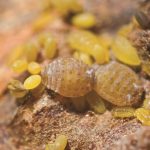South Australia’s Department of Primary Industries and Regions (PIRSA) has reclassified the Mornington Peninsula as a Phylloxera Exclusion Zone (PEZ) from a Phylloxera Risk Zone (PRZ) for the purposes of imports into the state, Vinehealth Australia announced to industry this morning.
Entry requirements for regulated phylloxera risk vectors from the Mornington Peninsula have therefore changed according to South Australia’s Plant Quarantine Standard.
The Victorian Government gazetted the Mornington Peninsula as a PEZ in March 2022. PIRSA’s recognition of the region as a PEZ brings South Australia into line with other states and territories.
Vinehealth is mandated under the Phylloxera and Grape Industry Act 1995 to assess the relative threat to South Australia’s vineyards posed by phylloxera and has been encouraging PIRSA to place a moratorium on endorsing the upgrade of any Phylloxera Management Zone until the completion of a review into the National Phylloxera Management Protocol (NPMP). According to Vinehealth, improvements in science have shown that the surveillance, detection, and disinfestation procedures in the National Phylloxera Management Protocol, including the rezoning procedure, are “not sufficiently effective” and are therefore “inadequate as the basis for rezoning to give sufficient confidence in the absence of phylloxera in the surveyed area”. Vinehealth also feels that historical movements between Phylloxera Infested Zones and the Mornington Peninsula are not adequately accounted for.
“The detections of phylloxera in Victorian vineyards this year have further emphasised that there is a considerable delay between time of infection to time of detection, and that detection is difficult,” Vinehealth said in its notice to industry.
“Vinehealth’s and PIRSA’s risk appetites and viewpoints on this decision [to recognise the Mornington PEZ] vary but are both valid,” Vinehealth advised.
“Vinehealth understands there can never be zero biosecurity risk associated with interstate trade, and that many South Australian wine businesses are reliant in some capacity on direct
or indirect interstate trade. Therefore, there is a need to balance maintenance of trade with minimising the risk of a pest introduction to the state.
“Given the risks inherent with serious pests such as phylloxera that are difficult to see and detect, slow to show impact in the vineyard, and are spread by a range of vectors ─ the best
protection for all vineyard owners and industry personnel is to ensure your own biosecurity measures are in place.”
Vinehealth identified three pathways with potential to increase the risk of phylloxera introduction to South Australia in light of PIRSA’s reclassification of the Mornington Peninsula as a PEZ. These are used grape harvesters, machinery other than grape harvesters, and grape bins.
Following PIRSA’s decision, Vinehealth advised members of industry to be informed and stay focused on what they can control, namely the operations associated with running their own vineyards, or those they work on or visit. It provided the following list of tips:
- If you are importing phylloxera risk vectors into South Australia (e.g., grapevine planting material, machinery and equipment used in vineyards, grapes, grape products (including wine, juice, must and marc) and diagnostic samples and vineyard soil, take the time to comply with the entry requirements.
- Know where you can find a map of the Phylloxera Management Zones.
- Know where you can find the latest version of the SA Plant Quarantine Standard to check entry requirements.
- Know where you can find handy resources – e.g., steps on importing machinery or equipment into South Australia, requirements for buying used machinery
- Know who to contact for help – call Vinehealth Australia (8273 0550) or PIRSA’s Plant Health Market Access team (8207 7814).
- Review your operations and always know where machinery, equipment and people have been before coming onto your property.
- Discuss biosecurity openly and often with your staff, contractors and suppliers, and ensure your expectations around biosecurity are being met.
- Ask all visitors to your vineyard which wine regions they and their machinery/equipment have visited in the 29 days prior, and record this for traceability purposes.
- Implement best-practice farm-gate hygiene for footwear and clothing, which can pick up and spread phylloxera.
- Know the visual symptoms of phylloxera in a vineyard. Monitor your vineyard blocks and identify any unusual vine growth symptoms. Mandatory reporting of phylloxera in every state is required by law. In South Australia, contact Vinehealth (8273 0550), PIRSA (8207 7814), or the Exotic Plant Pest Hotline (1800 084 881).
Further information:
- For the updated Phylloxera Management Zones map, refer here.
- For a table outlining differences in entry requirements into South Australia for regulated movement pathways from a PRZ compared to a PEZ according to SA’s Plant Quarantine Standard, click here.
- To obtain a copy of Vinehealth Australia’s full assessment, please contact Acting CEO Suzanne McLoughlin at 0412 859 882 or [email protected].
Are you a Daily Wine News subscriber? If not, click here to join our mailing list. It’s free!





















